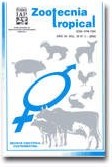
|
Zootecnia Tropical
Instituto Nacional de Investigaciones Agrícolas Venezuela
ISSN: 0798-7269
Vol. 26, No. 4, 2008, pp. 439-453
|
 Bioline Code: zt08080
Bioline Code: zt08080
Full paper language: Spanish
Document type: Research Article
Document available free of charge
|
|
|
Zootecnia Tropical, Vol. 26, No. 4, 2008, pp. 439-453
| es |
Producción de biomasa y calidad nutricional del estrato graminoide en un sistema silvopastoril dominado por samán ( Samanea saman  (Jacq) Merr) (Jacq) Merr)
Hernández, Manuel & Guenni, Orlando
Resumen
En la Estación Experimental La Antonia de la Universidad Central de Venezuela, se estudió el efecto de la
sombra del samán ( Samanea saman

) sobre la producción forrajera. El experimento se llevó a cabo en dos potreros
con distintas densidades de samán. El primero (PI) poseía un árbol y las especies dominantes en el estrato
herbáceo fueron: Digitaria swazilandensis

(Ds) y Urochloa arrecta

(Ua), mientras que el segundo (PII) poseía
un grupo de cuatro árboles con Ua y Urochloa mutica

(Um). Se determinó la producción de biomasa, el contenido
nutricional y algunos caracteres morfológicos del pasto durante 6 semanas de rebrote a lo largo de tres períodos:
transición lluvia-sequía 2003 (P1), transición sequía-lluvia 2004 (P2) y transición lluvia-sequía 2004 (P3). En PI
los porcentajes de densidad de flujo fotónico (DFF) bajo el dosel fueron 38, 82 y 41% a lo largo de P1, P2 y P3,
respectivamente; mientras que para PII fueron 33, 48 y 26%, respectivamente. La disminución en DFF produjo
un aumento del área foliar específica en todas las gramíneas. En P1 y P3 el índice de área foliar aumentó en Ds y
Ua y disminuyó en Um. Ds y Ua mostraron una alta plasticidad fenotípica a la reducción de luz, mientras que Um
la tuvo solo en P2. En general, la reducción en la humedad edáfica durante P2 afectó el rendimiento en materia
seca a pleno sol. En este período, una DFF de 48-82% pareció tener un efecto compensatorio sobre la producción
forrajera, debido a que la humedad del suelo mejoró en algunos casos. Durante P1, el contenido proteico del forraje
se incrementó bajo la sombra, mientras que los valores de P, contenido de pared celular y degradabilidad de la
materia seca no fueron tan modificados. La eficiencia de uso de la radiación (EUR) incrementó con la sombra, en
rangos de 0,7 a 1,5 g/MJ y 1,4 a 2,4 g/MJ para Ds y Ua, respectivamente. Estos incrementos en la EUR pudieran
contribuir significativamente a mejorar el grado de ajuste a la sombra en las especies mencionadas.
Palabras-clave
Sistemas silvopastoriles, gramíneas forrajeras, sombra natural, acumulación de materia seca, contenido de nutrientes, digestibilidad, eficiencia de uso de radiación.
|
| |
| en |
Biomass production and nutritive value of the grass stratum in a silvopastoral system dominated by saman ( Samanea saman  (Jacq) Merr) (Jacq) Merr)
Hernández, Manuel & Guenni, Orlando
Abstract
A study was carried out at La Antonia experimental station of Universidad Central de Venezuela to evaluate the
effect of shade of saman ( Samanea saman

) on pasture production. The experiment was performed on two plots
with different tree densities. The first plot (PI) had one saman tree and the herbaceous stratum was composed
by Digitaria swazilandensis

(Ds) and Urochloa arrecta

(Ua). The second plot (PII) had four trees plus Ua
and Urochloa mutica

(Um). Biomass production, forage nutrient concentration and some plant morphological
characters were measured during 6 consecutive regrowth weeks along three times of the year: 1) wet-dry period 2003 (P1), 2) dry-wet period 2004 (P2), and 3) wet-dry period 2004 (P3). At PI the percentages of photon
flux density (PFD) beneath the single tree canopy were 38, 82, and 41% along P1, P2, and P3, respectively,
whereas the corresponding values for PII were 33, 48, and 26%. Specific leaf area increased in all grasses as PFD
decreased. At P1 and P3, leaf area index increased in Ds and Ua, and diminished in Um. Ds y Ua showed a high
phenotypic plasticity to low PFD intensities, while Um had a greater response at P2. In general, the reduction in
soil water content along P2 decreased dry matter yield at 100% light. In this case, a PFD of 48 to 82% appeared
to have a compensatory effect on the pasture, since soil humidity was increased in some cases, improving total
forage biomass under shade. During P1 the forage protein content of almost all grasses increased under shade
when compared to full light, whereas phosphorus values, cell wall content and the dry matter degradability did
not show any important variation under shade. Pasture radiation use efficiency (RUE) increased from full light to
shade within the ranges 0.7 to 1.5 g/MJ and 1.4 to 2.4 g/MJ for Ds and Ua, respectively. These RUE increments
may have a significant effect on improving grass responses to decreased light under tree cover.
Keywords
Silvopastoral system, forage grasses, natural shade, dry matter accumulation, nutrient content, digestibility, radiation use efficiency (RUE).
|
| |
© Copyright 2008 - Zootecnia Tropical
Alternative site location: http://www.sian.inia.gob.ve/repositorio/revistas_ci/ZootecniaTropical/ztindice.htm
|
|
